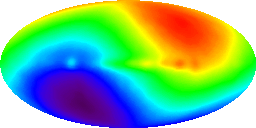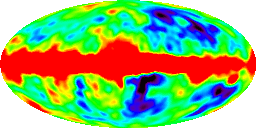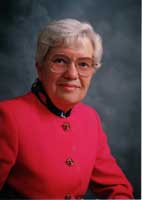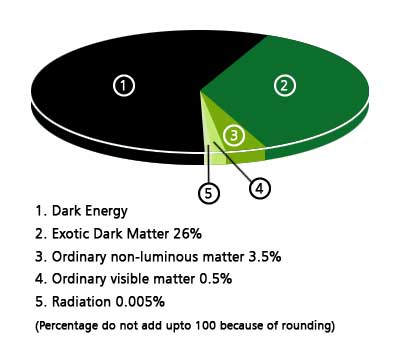 |
 |
 |
Volume
5 - Issue 09
SEPTEMBER 2007 |
|
By Prof. G Venkataraman
Loving Sai Ram and greetings from Prashanti Nilayam. In the last instalment, I tried, for the first time, to link up the macro and the micro; I hope you recall all that I told you. Today, I would like to take you further into truly amazing territory. But first, I would like to take you up in the sky and gaze into the Cosmos, the way some people have been doing. Basically, it is all connected with catching some signals that are coming to us from “out there” from “a long time ago.” Cosmic Radiations I hope you recall the story of the discovery of the so-called Cosmic Background Radiation – I discussed this in part two, in the February edition. Way back in 1960, two scientists accidentally discovered that we are constantly receiving a weak but steady doses of electromagnetic radiation from all around us. At first there was uncertainty about what exactly this mysterious radiation was and where it was coming from. But soon all those questions were settled, and since then, astrophysicists have been intensely investigating this cosmic background radiation as it is called. For accurate study, one has to send satellites into the sky with the ability to see in the infra-red and in all directions. This has been going on for some years now, and as a result of all these studies, the following is now known for sure.
What Went Bang? How do we know all this? Largely through studies of the CMB. In recent years, the CMB has been the focus of intense studies, and I shall soon refer to some of them. But first, I would like to address the question that has been sometimes asked: “What was it that banged?” This is a sort of rhetorical way of asking some sharp questions about the so-called Big Bang. You will recall that when the CMB was first discovered it was found that it was isotropic, that is to say, the same intensity was found when the observing telescope was pointed in different directions. True, some minute fluctuations were discovered later on – and these fluctuations, by the way, are very important for the consequences they produce! – but, the fact is that by and large, CMB is uncomfortably homogenous and uniform. How come? Now why one earth should that be a problem? Because, of one important technical hitch called the horizon problem. The Horizon Problem The details are a bit complicated to explain here but in brief the problem may be stated as follows. Let us go back to a long long time ago, say one second after the Big Bang. Based on the currently observed rate of expansion of the Universe, the Baby Universe when it was about 10-35 second old must have been a ball of radius about 1 cm! Incredibly small is it not?! Let us consider light emitted from some point on the surface of this ball having a radius of 1 cm. In 10-35 s, this light can travel only a distance of 3 x 10-25 cm. That means, for light to cross the Baby Universe, it would take an awfully long time; but in that time, the Universe would have expanded a good deal more. If you reflect on all this carefully, you would soon find that because of the rapid rate of expansion of the Universe, radiation within would have a hard time filling it up UNIFORMLY. But experiments show that radiation is indeed filling the Universe uniformly, apart from some important fluctuations, which, however are very minor in size [something like one part in 1000 or even less]. So how come radiation is filling the Universe so very uniformly?
If Ω has to have a value 1 a long time ago, and we are talking of real small times here, then there is a problem. What is the problem? Simple! Ω equal to 1 means the Universe is flat [see figure in QFI – 02]. Now it is easy to think of the surface of a huge sphere like the present surface as being flat but the surface of a bubble of radius one cm? Can one describe that as being flat? Not really! In which case, how was Ω almost equal to unity a long time ago? This difficulty, by the way, is called the flatness problem.
Hyper Inflation This figure above captures the essence of the Guth model for inflation. Suppose we start with the radius of the Universe as we know it to be today and work backwards based on the known expansion rate of the Universe. We would then get the curve labelled BBM [Big Bang Model]. The Guth model says that the Universe actually started off much smaller but suddenly blew up, in an incredibly short period of time – this is what inflation is all about. Why such a “crazy” model? So that two knotty problems explained in the text can be got rid off. OK, the model solves the problems all right; but is there any shred of experimental evidence that such an inflation actually occurred? Yes, and that is what the Nobel awards of 2006 for Physics imply! OK, but is Guth 100% correct? Any alternatives? Sure, but that story comes later! I know it all sounds pretty crazy but that is not the way Guth put forward his theory! He did it via systematic and professional arguments of course, but the gist of what he said was: Before the inflation, the Universe had a radius of only 10-50 cm or so, small enough for radiation to mix and fill it up uniformly. After the inflation, the Universe was too big as in earlier models but that was no problem any more because the Universe had already become filled uniformly. Guth’s inflationary model also took care of the flatness problem neatly and so there was much relief amongst cosmologists – two nasty questions had been settled; or so it seemed! Science always progresses this way, in fits and starts. First there is a problem; then there is a fix, and things seem, fine; but soon it turns out that things are not all that hunky dory because when one looks at the fine print, there are problems again. So back to the drawing board; a new model, and relief once again; but closer scrutiny and bugs again! This, however, does not dishearten physicists because there is always work to do, exciting work! That is why Feynman once said that when a theory works, physicists then become busy demolishing that theory by finding faults! What I am driving at is that Guth’s model also has problems of its own! But that is a different story. The 2006 Nobel Awards for Physics Let me now cut to Stockholm, October 2006. That is when the Nobel Awards are announced, and the announcement was made that the Physics awards went to two people associated with the exploration of CMB. They are: John Mather of NASA and George Smoot of the University of California, Berkeley Campus. Using the COBE [COsmic Background Explorer] satellite, they got a fantastic mapping of the CMB all across the sky. Their results were path breaking. On the one hand, they showed how uniform the radiation was all over; and yet, when see with a “microscope”, there were small but very significant variations that tell their own tale. One can understand all this in the following manner. Let us say you are in a spacecraft and coming towards the Earth from outer space. As you approach, the first thing you would notice is that the planet is spherical. As you draw closer to the Earth, you would see the surface divide into continents and oceans. You would then begin to see that the Earth's surface is not absolutely smooth but has ups and downs, connected with the presence of mountains, cities, forests and deserts that cover the continents. It has been the same way with the study of CMB over the years. When astrophysicists first looked at the microwave sky, thirty years ago, they noticed it was nearly uniform. As observations improved, they began to detect various features associated with CMB. Finally, in 1992, the COBE satellite made the first detection analogous to seeing "mountains on the surface of the Earth": it detected cosmological fluctuations in the microwave background temperature, as they existed when the Universe was about 380,000 years old. This thus represents data going back a very long time, to a time much earlier than possible from earlier experiments.
The implications of the study carried out by Mathers and Smoot are many and we certainly cannot go into all that here – the very fact they were given the Nobel is enough to show that their findings are of far-reaching significance. I am drawing attention to the COBE because one of the things it has given strong support to is the idea of inflation; so inflation is not mere speculation any longer, but something that definitely seems to have happened during the early history of the Universe. [That does not mean Guth’s model is the last word! There are many other equivalent scenarios, but all rely on some form of inflation – that story would come later maybe.]
This figure, produced by the COBE science team, shows three false color images of the sky as seen at microwave frequencies. The orientation of the maps are such that the plane of the Milky Way runs horizontally across the center of each image. The way to understand these figures is as follows. Now the actual temperature of the CMB is 2.725 degrees Kelvin or Absolute. Electromagnetic radiation with this temperature would be in the microwave region. Suppose the detector observes all radiation within a band ranging from 0 degrees Kelvin to 4 degrees Kelvin. This would be a wide window, and on this scale, the data shows uniformity [figure a], that is to say, the CMB appears uniform all across the Universe. Narrow the detection range now to the band 2.721 to 2.729 degrees Kelvin. The data now shows temperature fluctuations of the type seen in figure b. From the exciting studies on the fingerprints left by the early Universe via the CMB, I now turn to physics at small distances. There has been hectic activity in this area, and many amazing discoveries have been made, with a bearing on Cosmology. In fact, one can see the manner in which Cosmology and particle physics are influencing each other. Here is an example. Some years ago, astrophysicist Vera Rubin began carefully studying various galaxies in the Universe. Her studies lead her to conclude, that many galaxies actually had much more mass than the light emitted by them would allow us to conclude. You see, when we look up in the sky and see something, we say, “Ah ha! There is something up there. If we see nothing, we say, nothing is over there.” Vera Rubin found out that we cannot always assert in this manner. Visually, the galaxies seemed to suggest that there was only so much matter in them. A careful analysis of the physical parameters suggested something very different, viz., there was much more to the galaxies than evident to the eye; in other words, there was Dark Matter, not visible to the eye, or in the ultraviolet, infrared, etc.
Astronomers said, “Hey, wait a minute. Sure we cannot see the brown dwarf but how about detecting its presence by gravitational microlensing?” The idea behind this technique is illustrated in Figure 4. In a manner of speaking, it is all like the famous experiment done earlier to detect the bending of light by gravity; this time, the bending is used to detect the presence of MACHO. Keeping this in mind, it should be easy to follow Figure 4.
This figure illustrates the principle of microlensing, using which MACHOs are detected. In (a) we have a star whose light reaches the Earth without any obstruction. In (b), a MACHO intervenes, eclipsing the star. As a result, light beams that would have gone away from the Earth are now pulled in. This causes a net enhancement of the light intensity if starlight. In (c) is illustrated how the intensity of starlight peaks, while the MACHO is transiting across the line connecting the Earth to the star. Have MACHOs been observed? Yes, many of them; so we can say dark matter does exist. OK, MACHOs exist but do they account for all the dark matter that could be present? Any other types of dark matter possible? Of course, say the scientists, and they suggest that certain types of elementary particles called WIMP [Weakly Interacting Massive Particles] could exist, and physicists are busy looking for them; thus far, none have been found. Cosmic Census What I want to impress with the above is that one thing leads to another, and dark matter, the value of Ω, the fate of the Universe, elementary particle physics, all have begun to influence each other in ways never before imaginable. Let me now give you some more taste of this! Suppose we do a Cosmic Census, meaning, adding up all the known masses in the Universe; and we represent the result as a pie chart. This was done some years ago, and it was found that if one added all the known masses, including a good estimate of the dark matter, then it all added up to just about 30 % of the mass needed to make Ω equal to 1; remember, Ω is the magic parameter that determines the fate of the Universe, and the value of Ω depends on the amount of matter in the Universe. Current estimates suggest that Ω is in fact pretty close to 1; in which case, the question becomes: “What is it that is missing to make up for the mass needed to make Ω equal to 1?”
This pie chart is essentially an approximate “census’ report of the Cosmos. [The percentages do not add up exactly to 100 because of rounding-off errors.] Many decades ago, people thought the Universe was filled only with matter and radiation, with matter being made up of galaxies, which in turn were made up of stars and their planets [if any]. As the figure above shows, the view is now very different. Ordinary visible matter forms only a very small part; besides this, there is a lot of dark matter. But that is still not the end of the story. The requirement that the value of Ω be close to 1, now suggests that besides dark matter, there is also dark energy! In fact, the contribution due to dark energy seems to dominate the contents of the Universe! Dark Energy That is where dark energy entered the picture, and to get ahead of the story, let me mention at this point that the COBE studies [and some earlier less precise ones] give strong support to the idea of dark energy. So you see, why COBE results are so important – they give support to the idea of inflation, and they also strongly suggest that indeed there is a thing called dark energy. At this point, you might be wondering: “Who on earth got this idea of dark energy? Why does the Universe need dark energy? How does it help?” and so on. Let me now try and give some answers to the above questions. Astrophysicists have in recent years been carefully studying data from ancient supernova [see QFI part four in the April edition for some information about supernovas], and they have come to the conclusion that quite possibly, the Universe is not only expanding, but that the rate of expansion strongly suggests the value of Ω ought to be close to unity. The COBE results not only say the same thing but even more emphatically. Thus, many things started pointing to the same thing: 1) the value of Ω has no choice but to be close to unity. Even as people were wondering about the acceleration of the expansion of the Universe, there was the question about something missing in the Cosmic census, something that had to be put in to make the value of Ω come very close to unity. 2) At the same time, the Cosmic census shows that even if we add up all the mass in the Universe, including the mass associated with dark matter, the value of Ω comes nowhere near 1. So something is missing; what is that? That something, said experts, is dark energy! Now you just can’t get up and say, “Hey, you know what? There is a repulsive force out there that is driving the different parts of the Universe apart, forcing it expand rapidly, instead of allowing gravity to shrink it, which is what one would normally expect.” This is too serious a matter to do hand-waving as they say. I wish to assure you that serious science is not done this way, and in fact, much work has been done to give a reasonable theoretical foundation for the concept of a repulsive energy that would take care of the observed expansion of the Universe, and the value of Ω it suggests. But I am afraid I cannot go into those technical details. Let us take comfort, that thanks to COBE results we not only know that Ω is close to unity, but also that there is a way to understand the expansion of the Universe that this value of Ω suggests, an expansion that has actually been observed. There is another curious thing about this dark energy business. Remember the famous Cosmological parameter Λ that Einstein introduced and then abandoned, declaring it to be the greatest blunder of his life? [See QFI – 02.] It turns out that this dark energy is closely related to that Λ! Einstein would sure have loved that, had he been alive! Sometimes, history turns around in a strange manner! The Universe created by God is full of mysteries! More about them next time, when you would encounter some really amazing concepts. Meanwhile, I wish to leave you with small question, which is: “Name a well known rock star who recently completed his Ph. D thesis in astrophysics and submitted it for examination after more than three decades of absence, working in the music world!” We will publish the names of all who have submitted correct entries! You know where to write to us, isn't it. It is always - h2h@radiosai.org.
|
||||||||||||||||||||||||||||||||||||||||||||||||
| You can write to us at : h2h@radiosai.org |
Vol 5 Issue 09 - SEPTEMBER 2007
|
Best viewed in Internet Explorer - 1024 x 768 resolution. |












